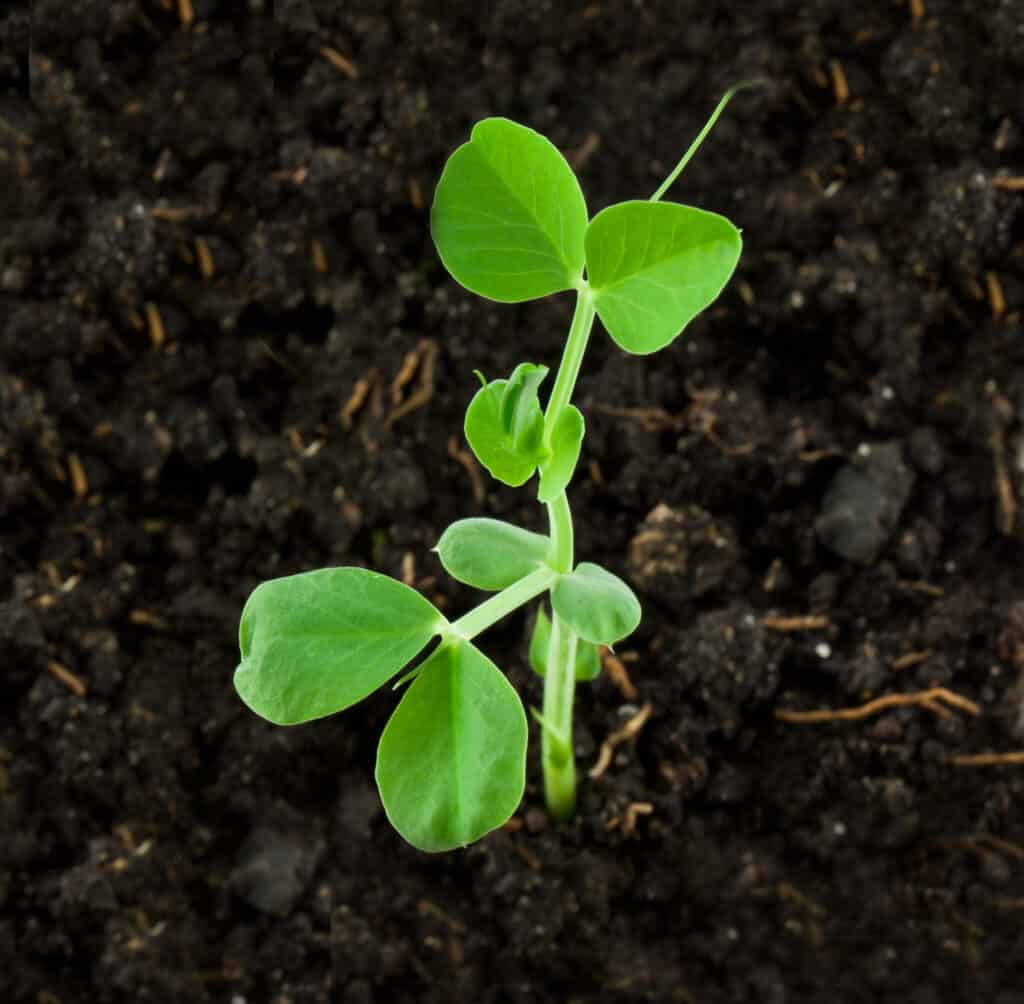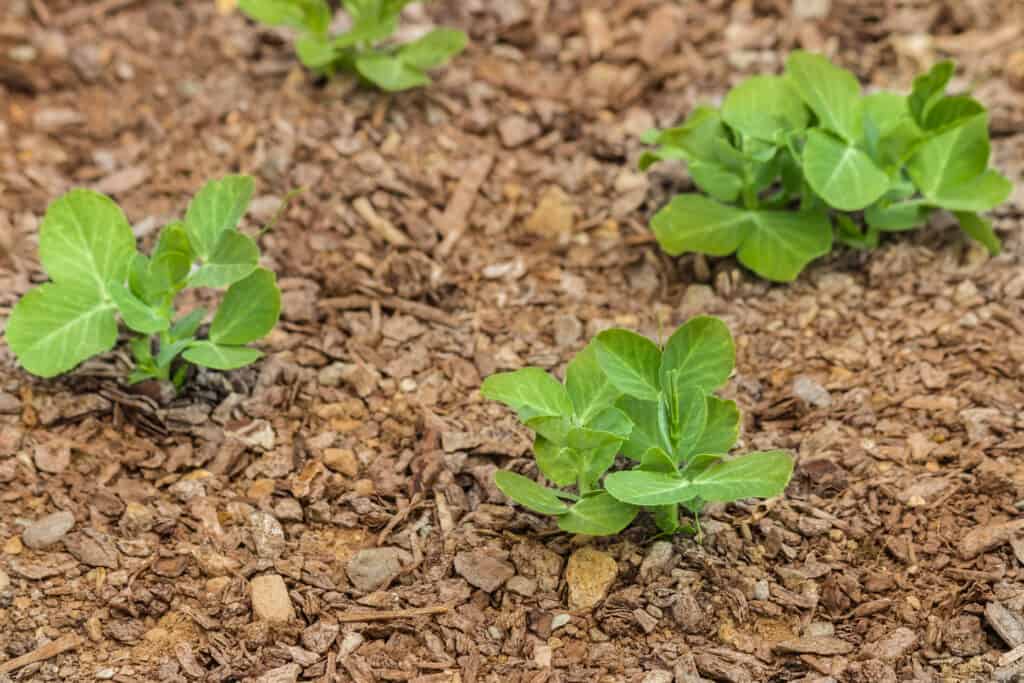
Peas are a cool-weather crop. Sow pea seeds in early spring as soon as the soil can be worked or in late summer. Grow peas so that they come to harvest when the weather is cool.
Peas can be classified by how large they grow: dwarf, medium, or tall. The taller a pea plant grows the larger the yield. Tall varieties require a long growing time; smaller varieties require less growing time.
Peas mature in 55 to 70 days depending upon the variety.
Peas also can be classified by use. Some peas are for shelling, some have edible pods, and others can be shelled or eaten pods and all. Shelling peas can be used fresh or dried and cooked. Edible pod peas are often called snow or sugar peas. Peas that are shelled and eaten fresh are called green peas, garden peas, or English peas.
Good Products for Seed Starting Success at Amazon:
- Jump Start Germination Station w/Heat Mat Tray, 72-Cell Pack, Dome
- Espoma Seed Starting Mix
- 200 Count- Jiffy 7 Peat Soil Seed Starting Plugs
- Seed Starter Kit with Humidity Dome (120 Cells Total Tray)
- AgrobriteT5 Fluorescent, 2-Foot, Grow Light System
Sow garden peas in the garden not later than two to three weeks before the average last frost date. If you wait, the yield will be small and will likely not justify the space they need in the garden.

Peas seed sowing time
Young garden pea plants grow best at 59℉ to 68℉ (15℃-20℃). If you can’t plant early, plant ‘Wando’ which can tolerate some warm weather late in spring. (For fall peas, plant in late July or early August.)
Peas can be planted as early as the spring thaw; they can sprout at temperatures as low as 40℉ (4℃).
Sowing for spring harvest
- 5-6 weeks before the last frost in spring as soon as the soil can be worked: direct-sow in the garden.
- Peas can be planted as early as the spring thaw; they can sprout at temperatures as low as 40℉ (4℃).
Sowing for fall harvest:
- 10-12 weeks before the first frost in fall: sow quick-maturing variety in the garden.
Peas planting details
- Sowing depth: 1-2 inches (2.5-5cm)
- Space between plant after thinning: 1-3 inches (2.5-7cm)
- Days to sprout: 8
- Days to harvest: 60-80
- Storage period: 1-2 weeks
- Seeds per 100-row feet: 1 pound (.5 kg)
- Yield per 100-row feet: 40 (18 kg)
Good Products for Raised Bed Growing at Amazon:
- Galvanized Raised Bed 8×3
- Cedar Raised Bed 4×8
- Elevated Cedar Planter 4×2
- Walk-In Greenhouse Tunnel 15x7x7
- Row Cover for Freeze Protection 10×30

Peas sowing and planting tips
Grow peas from seeds or seedlings. Pea seeds are viable for 3 years.
Smooth-seeded peas are usually sown for the earliest crop, but they are small and by no means sweet. It will pay the home gardener to plant wrinkled peas. Sow them a week or two after the earliest crops go in.
Sow seed indoors 8 to 6 weeks before the last frost in spring then transplant seedlings to the garden when they are 4 weeks old and a few weeks before the last expected frost; peas can withstand a light frost.
Direct sow peas directly in the garden as soon as the soil can be worked in spring or in late summer. Peas must mature before the weather gets hot. Late planting can cause poor results.
Peas will germinate in 9 days at 60°F (16°C) or in 35 days at 40°F (4°C); the optimal soil temperature for starting seeds is 75°F (24°C). The optimal soil temperature for growing peas is 50° to 75°F (10-24°C).
Good Products for Seed Starting Success at Amazon:
- Jump Start Germination Station w/Heat Mat Tray, 72-Cell Pack, Dome
- Espoma Seed Starting Mix
- 200 Count- Jiffy 7 Peat Soil Seed Starting Plugs
- Seed Starter Kit with Humidity Dome (120 Cells Total Tray)
- AgrobriteT5 Fluorescent, 2-Foot, Grow Light System
Sow seeds in peat pots 2 to 3 weeks before planting out if you want to start plants indoors. Sow seeds ½ to 1 inch (2.5 cm) deep.
In the garden, space peas 2 to 3 inches (5-7.5 cm) apart; later thin successful plants to 4 inches (10 cm) apart. Add aged compost to planting beds in advance of transplanting. Peas prefer a soil pH range of 5.5 to 6.8. Grow peas in full sun for best yield.
When sowing peas, put poles, vine nets, wire fencing, or trellis in place for plants to climb. Install wire or strong supports between posts for bush varieties. Install sturdy poles, a wire fence, or a trellis supported by posts for pole varieties.
Sow seed every 3 weeks until late spring for an uninterrupted harvest.
Keep the soil just moist. Letting the soil dry out will interrupt pod development.
Fertilize with fish emulsion or a soluble complete fertilizer at half strength.
Common pest enemies include aphids, cabbage loopers, cabbage maggots, cucumber beetles, flea beetles, snails, and slugs.
Common diseases include bacterial blight, downy mildew, fusarium wilt, leaf curl, and powdery mildew.
Interplanting peas
Plant peas with carrots, celery, chard, corn, cucumber, eggplant, potatoes, spinach, and strawberry.
Container growing peas
Peas will grow in containers, but it takes space to produce a reasonable crop. Choose a container at least 12 inches (30 cm) deep.

Pea types and varieties
Types of peas
Peas are indeterminate (climbing) or determinate (bush or dwarf). The taller the plant grows, the larger the yield. Tall types require a fairly long, cool spring and often do not mature until summer. Tall peas should be grown on poles, fences, or trellises.
Some peas are for shelling, some have edible pods, and others can be shelled or eaten whole. Shelling peas can be used fresh or dried and used in soups. Edible pod peas are called snow or sugar peas. Peas that are shelled and eaten fresh are called green peas, garden peas, or English peas.
Recommended varieties
- Garden peas, also called English peas: ‘Knight’ and ‘Dakota’ are harvested early; ‘Lincoln’ is a sweet heirloom; ‘Green Arrow’ is a flavorful climber; ‘Tall Telephone’ is a sweet climber; ‘Alaska’ is a short-season variety; ‘Little Marvel’ and ‘Wando’ are small bush varieties. A good variety for freezing is “Frostie.” Good varieties for canning are “Pride” and “Perfection.”
- Sugar peas: ‘Super Sugar Snap’ is a sweet climber; ‘Sugar Snap’ is a pole pea; ‘Sugar Ann’ is a bush pea.
- Snow peas: ‘Oregon Giant’ is a large podded; ‘Mammoth Melting Sugar’ is long podded.
Peas Botanical Name: Pisum sativum var. macrocarpon. Peas are a member of the Fabaceae family.
Peas rlated articles on Harvest to Table:
How to Cook and Serve Garden and Snap Peas
How to Prepare Spring Peas with No Recipe
English Peas, Spring Onions, and Roasted Almonds
Baby Beets, Baby Carrots, and Sugar Snap Peas Salad
How to Cook and Serve Snow Peas
Garden Planning Books at Amazon:
- Tomato Grower’s Answer Book
- Vegetable Garden Almanac & Planner
- Kitchen Garden Grower’s Guide Vegetable Encyclopedia
- Vegetable Garden Grower’s Guide















